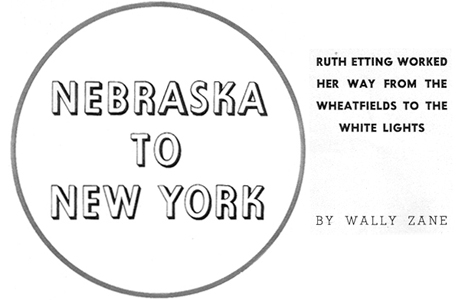This prose snapshot of songbird Ruth Etting might fairly be said to be a doctored “photo”—or at the very least retouched. For this profile, from the April 1935 issue of Popular Songs, makes no mention of Martin “Moe the Gimp” Snyder, a gangster to whom young Ruth was wed in 1922 and who had a major impact on her career.
After achieving huge success in radio, Broadway, recordings, and movies, Etting divorced Snyder in 1937, having fallen in love with her pianist, Myrl Alderman, who was nearly ten years her junior.
That old saying “Heaven has no fury like a mobster scorned” applies here, as Snyder soon plugged Alderman with a bullet, spending a year in jail before being released on appeal.
The surrounding scandal seems to have pulled the plug on Etting’s career, alas, though she would go on to marry Alderman and, one hopes, live happily ever after.

 HEN Ruth left her happy home on a Nebraska farm to go down to Chicago to study art, she hadn’t a thought in the world about cabaret entertaining, torch songs, crooners, radio broadcasting, Broadway song and dance shows, Florence Ziegfeld or Hollywood—yet all of these have played important parts in her eventual life.
HEN Ruth left her happy home on a Nebraska farm to go down to Chicago to study art, she hadn’t a thought in the world about cabaret entertaining, torch songs, crooners, radio broadcasting, Broadway song and dance shows, Florence Ziegfeld or Hollywood—yet all of these have played important parts in her eventual life. She wasn’t particularly concerned with the thought of being alone in a big strange city. Even if she had been, she would have gone anyway, for she had plenty of determination.
She wasn’t particularly concerned with the thought of being alone in a big strange city. Even if she had been, she would have gone anyway, for she had plenty of determination.
